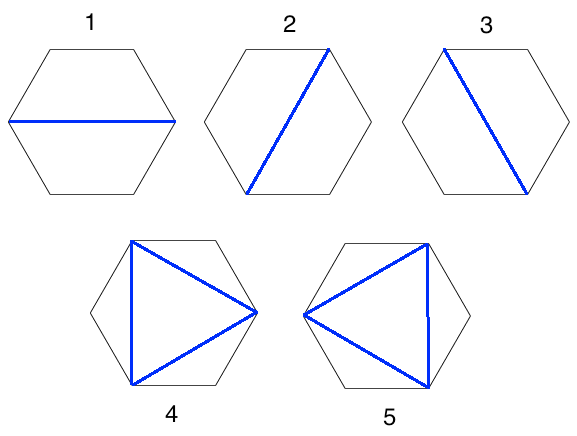A geometric proof that is possible for
16 Aug 2021
To nobody’s surprise, I was on MSE tonight, and saw a simple question about
group theory. The original question doesn’t matter as much as a question it
made me wonder to myself:
Is there an so that the dihedral group is a subgroup of the
symmetric group ?
Intuitively it feels like the answer should be “yes”, but I wasn’t able to
come up with a proof myself. Thankfully it didn’t take much googling to find
an excellent example due to pjs36. I’ll show it for completeness, but you can
find the original post here.
The idea is to embed in by working with subpolygons
instead of vertices. This is analogous to showing the symmetry group of a cube
is by looking at the diagonals inside the cube, rather than
looking at the vertices/edges/faces individually.
Since a picture is worth a thousand words, I’ll steal pjs36’s picture:

If you know where these subpolygons get sent, you actually know where the
whole hexagon gets sent! This witnesses in a
starkly beautiful way.
It got me wondering, though. Can we run a similar argument to get
for other choices of ? Since you’ve read
the title of this blog post, you know the answer is “yes”. But at this point
I should issue a quick clarification: This (very clever!) idea is not actually
my own – I found it in yet another mse post. I was already planning on
writing up a blog post about this problem, but when I found the solution I knew
I had to talk about it. Now, let’s talk through how we
might have solved this problem ourselves:
Obviously if is prime, then first shows up as a subgroup of
in the natural way (by permuting the vertices). We can’t do
any better than this since for prime, for any .
A moment’s thought (or more likely, quite a few moments’ thoughts) shows that
actually for . The idea here is
that has a cycle. The order of an element
is the of the cycle lengths in ,
so even though might divide , there’s no way to get an
of things to equal .
Pjs36’s solution feels like it should generalize, and
looking more carefully at the pictures above, we’re considering the -gons
and -gons living inside of our -gon… This idea links up well with our
counterexamples from earlier, since the subpolygons of an -gon are exactly
the -gons for and prime powers are special in the
divisibility order.
We want to make (the number of generators of our symmetric group) as small
as possible, so we should make the subpolygons we look at as big as possible
(so that there aren’t many). Since we know from our earlier
investigation that -gons are the obstruction to “shrinking” ,
whatever construction we do should give us objects to permute when we look
at a -gon.
Eventually, this might lead us to consider the many -gons
living inside our -gon. In the -gon case, this means we’re considering
the many -gons (that is, just the vertices), which is exactly what we
expect. In the -gon case, this mean we consider the -gons and
the -gons, but this is exactly pjs36’s original example! In the
case of a -gon, this means we’re looking at the
-gons (there’s of them), the -gons (there’s of them),
and the -gons (there’s of them). Notice here how we’re able to keep
the number of objects small (there’s only things we’re permuting)
by keeping our subpolygons big.
In general, let’s write where each is a (maximal)
prime power. We can find many -gons living inside our -gon,
and every symmetry of our -gon permutes these subpolygons amongst themselves.
That is, we get a permutation in for each .
Next, we can glue these together into a map
which I claim is actually injective.
To see why, say that some is in the kernel of the above map.
Then it’s in the kernel of each , so
fixes each of our subpolygons. But this can only happen if fixes the
entire -gon, so and our map is injective.
Now we see the light at the end of the tunnel! We have an embedding
, and we want an embedding
for some . But there’s an “obvious”
way to do this! If you have a permutation of objects and a permutation of
objects, we can just put them next to each other and call it a permutation
of objects.
Using this “put them next to each other” embedding, we see that
So embeds in , as we’ve seen.
Likewise, each embeds in , which agrees with
our earlier experiments. Finishing our concrete example from earlier shows
embeds in
,
which is much smaller than the obvious
!
As one last question: how much smaller is it? If , then let’s call
each a Principal Divisor of . Moreover,
let’s write
According to
Upper Bounds on the Sum of Principal Divisors of an Integer
by Eggleton and Galvin (up to change of variable name, to be consistent with
the other variables in this post):
If is any positive integer with principal divisors, and
each greater than , then
Moreover, this holds with equality when .
This tells us that we can embed in a symmetric group with generators
that shrink rapidly as the number of principal divisors of increases
(provided each is not individually too small).
We’ve shown that ,
but maybe we can do even better!
As a (fun?) exercise, can you show that that isn’t the case?
That is, if embeds in , show that
, so our construction here was best possible.
The proof is similar to how we showed can’t embed in
for .
